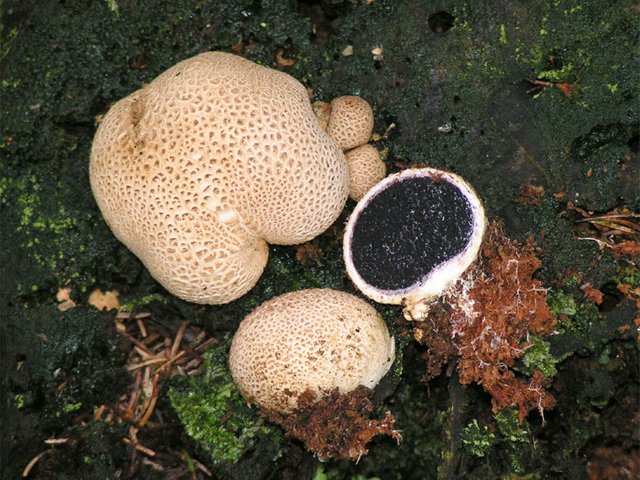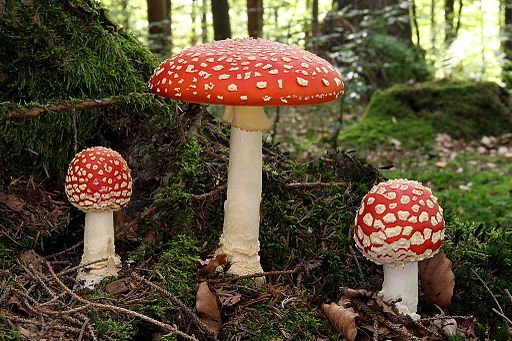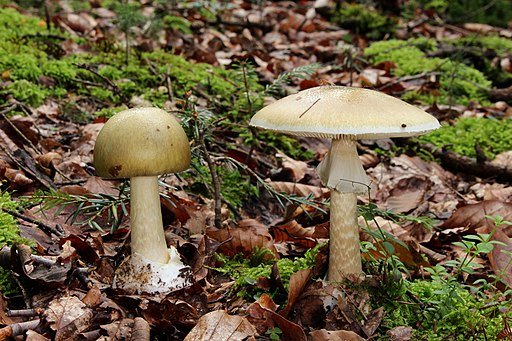A Mushroom Adventure In My Own Back Yard
Before you continue:
I am not an expert on fungi. I wouldn't even qualify as a hobbyist. I just enjoy taking pictures of natures tiny little details. Sometimes, curiosity gets the best of me, and I find myself trying to figure out exactly what it is that I was looking at. The following post is the result of one such instance.
Last weekend, I got the chance to go for a relaxing stroll through the small wooded area on the back corner of the pasture. We were in between cold snaps; the previous few nights had dropped down into the mid to upper 20s, but temperatures on this day had made their way up into the 40s. I didn't expect to find very many insects out and about, so my primary objective was to find a few photogenic fungi - and I did find a few.
Poo-Shrooms

Original Image
These were growing in an old pile of cow poo. They were only ~0.5-1 cm in diameter. They didn't seen very remarkable to my unaided eye; I thought it was cool that they formed little canals, and that was why I took the pictures. It wasn't until I got home and looked at the images on my computer that I began to notice how the chocolate brown and the baby blue hues played against each other. I also couldn't help but wonder where those little canals lead to.
Wiry Mushrooms

Original Image
These little guys were clustered together in a little crevice on a rotting, still-attached branch of an oak tree. It looked like a good climbing tree, but there was only one branch that I could easily reach. When I tested it to see if it would hold my weight, it crumbled in my hand, and I found these cool looking mushrooms on one of the pieces. They were only ~1-2 cm in length, so I would have missed them had that particular piece not broken off in my hand.
Unfortunately
I have no idea what the above specimen are, and I don't even know where to begin the research to find out. However, I was able to find another mushroom species that looked somewhat familiar. I thought I knew what it was, or that I was at least close enough that I would be able to nail it down to the species level.I Found A Puffball

Original Image
I found a bunch of these clustered together on a decomposing oak log that had long ago fallen from a tree. I kind of recognized them from pictures that I have seen posted on a "Mushrooms of Arkansas" forum group. Apparently, this was a good year for them, because people were finding them all over the place. This was one of the younger looking of the specimen that I found. Most of them were a darker brown and beginning to shrivel up.
Old Puffball

Original Image
Earlier in its life, this mushroom would have been white or tan to light brown in color. Those darker brown spots (they kind of resemble epithelial tissue, to me) would have been more like soft spines; however, they wear off as the mushroom ages.
Which Puffball Is It?
I knew these mushrooms by their common colloquial name, puffballs, but what I didn't realize was that the term 'puffball' encompassed an entire collection of different types of fungi. And, the thing about identifying mushrooms is that it can be extremely important to classify them down to the species level, especially for those interested in foraging for edible mushrooms (I am not close to knowledgeable enough for that!). So, I did a little bit of research and asked a few local experts, and I was able to verify my suspicion that this is most probably Lycoperdon pyriforme.
The Stump Puffball
One of the common names for L. pyriforme is the stump puffball. It earns this nickname from the fact that it is saprotrophic, usually found growing on dead hardwood or conifers where they get their nutrition by decomposing the wood. They have a habit of growing in clusters - sometimes scattered, but usually densely packed to the point of almost growing on top of one another. After looking at other pictures, I realize that I happened upon a rather small cluster.Just A Small, Scattered Cluster

Original Image
What's In A Name?
As a collective group, puffballs get their name from the fact that the mature fruiting body is generally a roundish mass that eventually releases its spores by coughing them up into the air in a visible cloud. Some species of puffball are able to generate their own propulsive force to eject the spores. Lycoperdon pyriforme, however, must rely on some outside stimulus. As it ages, it will begin to develop a weak spot at the top of the fruiting body. At this point, something as simple as an animal bumping against it, a drop of rain falling on it, or even just a stiff breeze can jar the mushroom enough to send its spores poofing up into the air. Indeed, I did notice a spore cloud rising from one of the mushrooms when moved the log. Some believe that it was this phenomenon that led to the genus name for many of the puffball mushrooms ("lyco-" is of Greek origin and means "wolf"; -perdon refers to flatulence) and the other common name for L. pyriforme, the wolf fart mushroom. Now, I've never been around a farting wolf, but I can imagine that in a cold enough climate that puff of warm, moist air might look similar. (Don't lie! You just got a visual image, didn't you?)The species name "pyriforme" refers to the pear shape of the fruiting body.
What's On The Inside?
After noticing that spore cloud, I got curious about what may be inside of the mushroom. If this had been a fresh specimen, then the inside would have been fleshy and white. However, as L. pyriforme ages, the inside begins to turn a yellow to olive color before eventually drying out and forming a brown, fuzzy mass of spores.** A Note Of Caution *Inhaling large quantities of puffball spores can be dangerous. In fact, it can result in a pneumonia-like health condition called lycoperdonosis.
Wolf Fart Spores

Original Image
How To Identify A Wolf Fart
The fruiting body of L. pyriformes usually starts out round but takes on its namesake 'pear' shape as it ages. The mushroom will usually range from 2-3.5 cm wide and can be as tall as 4.5 cm. When they are young, the fruiting body will be covered by lots of small spiny projections; however, those wear away with age, as seen in my images, above. The pear shape is the result of the base of the mushroom pinching off where it plugs into the surface of the wood that it grows on.L. pyriformes Plugged In

Original Image
If you are able to dig down into the substrate where the mycelia are growing, you will see a mass of mycelial strings that grow out from the base of the stem and spread throughout the growing medium.
L. pyriformes Mycelia In A Decomposing Log

Original Image
If you're really serious about identifying a wolf fart, you can do a KOH test, a spore print, and even look at the spores under a microscope. For L. pyriformes, there should not be any reaction to KOH on the surface of the mushroom. The spore print should be olive in color, and under a microscope, spores should be ~ 3.5-4.5 µm in diameter and appear round and smooth.
Dangerous Look-Alikes
Stump puffballs do have a few dangerous doppelgangers. For example, the common earthball mushroom, Scleroderma citrinum, can look very similar to L. pyriformes on the outside; however, it will be pale gray to black (depending on age) on the inside instead of the white color that we would expect to see in a young stump puffball or the brown color of an older specimen.Scleroderma citrinum

Image Credit
It can also be easy to confuse the stump puffball with some of the mushrooms from the Amanitaceae family, including the infamous Amanita muscaria and Amanita phalloides.
*** It would be difficult to mistake the mature fruiting body of either of these mushrooms with that of L. pyriformes; however, both go through a button phase before the cap opens up to reveal the gills where they resemble a puffball. To rule these out, you can simply cut the specimen down the middle. If the inside is one uniform, marshmallow-like mass, that is a good indication that you have a puffball. On the other hand, if you can see a separation where the umbrella is forming but just hasn't yet separated from the stem, then you do *not* have a puffball.In Conclusion
If you are interested in finding getting outside and finding mushrooms, it is not too late despite the cold. I spent an hour or so outside in the woods behind my house and found several cool fungi to take pictures on. I have no idea what some of them were (let me know if you do!), but based on my research and the advise of local experts, I am confident that I have identified one of the specimen as Lycoperdon Pyriformes.Thanks for reading my post! I hope you found it both entertaining and educational.
Resources
Tom Volk's Fungus of the Month for November 2001MushroomExpert.com - Lycoperdon pyriformes
Lycoperdon pyriforme by Gary Emberger, Messiah College
First Nature - Lycoperdon pyriforme Schaeff. - Stump Puffball
Missouri Department of Conservation - PEAR-SHAPED PUFFBALL
Lycoperdon pyriforme (Morganella pyriformis)
.jpg)


Hi sustainablyyours,
This post was nominated by a @curie curator to be featured in an upcoming Author Showcase that will be posted Late Tuesday/Early Wednesday (U.S. time) on the @curie blog. Apologies for the delayed notification 🙂
NOTE: If you would NOT want us to feature your post in the Author Showcase please reply, email, or DM me on Discord as soon as possible. Any photos or quoted text from your post that we feature will be properly attributed to you as the author.
You can check out our previous Author Showcase to get an idea of what we are doing with these posts.
Thanks for your time and for creating great content.
Akpan (@curie curator)
[email protected]
That's awesome! Thank you!! {:o)
Cool close-up photos you got there. They made me remember my childhood days of country-side living. Thanks for sharing them! 😊
At first I thought the stump puffball is the one I was thinking of as edible until I read further and spotted Scleroderma citrinum. The latter is the one which looks like the what I have tried eating as sautéed mushroom. It tasted good.
I also tried something that looks like the Amanita phalloides but maybe it is a different variety. I heard something like that is poisonous.
You're right. It probably was the stump puffball. The ones in my picture are really old, and you wouldn't want to eat them at that point. When they are young, they look very similar to the picture of Scleroderma citrinum. Scleroderma citrinum isn't edible.
Oh, so I interchanged what is edible and not. Thanks for clarifying that. 😊 The somehow old version of the edible ones tasted bitter so yes, old ones are not recommended for consumption.
One of my aunts was a forager and mushrooms were her favorite thing to hunt. Your post reminds me of how she used to describe the do's and don'ts of mushroom gathering. I would never be detailed enough to try it on my own.
My aunt had them dried at her house and I can remember delicious pasta sauce from there.
You have great macro shots and I love the blue in the top shot too. I once saw a big patch of something like your mycelial strings, and now I know what is was.
Today is the first time I have ever considered anything about wolf farts, so thank you for that :)
Thanks for reading!
I need to find someone who knows the do's and don'ts. I don't even know what to look for. I am definitely not a mushroom forager.
My aunt always had stories of how others had messed up. These little mushrooms are devious!
Ahh, awesome mushie post! I love finding puff balls, new or old, doesn't matter. (I don't eat the old ones but they are fun to step on hahah) They aren't the tastiest mushies to me, but on days where I forage and find nothing else, a few puffies can't go wrong.
We see lots of amanita around here, fly agaric as well as destroying angel and amanita pantherina (super beautiful btw). We of course leave them be, but they are always fun to find.
Thanks for sharing this knowledge! Way to get out and explore, I love mushroom season!
Xx ToL
Thanks! I would like to try eating some puffballs, but I'm not confident enough in my identification to risk it. I'll have to get some more practice in.
Are there any other dangerous look-alikes to watch out for?
The dangerous look alike I've found are same as what you have described, amanita that haven't opened yet, but if you slice them down the middle you should see the Beginnings of their skirts and gills.
I don't see other look alikes in my area, but I'm not sure about other areas! I have found the more I get out and get hands on experience with foraging and identifying, the more comfortable I get with the area and what grows here.
Have fun collecting and identifying! Even if you don't eat them, it's still a blast!
This post has been voted on by the SteemSTEM curation team and voting trail in collaboration with @utopian-io and @curie.
If you appreciate the work we are doing then consider voting all three projects for witness by selecting stem.witness, utopian-io and curie!
For additional information please join us on the SteemSTEM discord and to get to know the rest of the community!
Friend, unfortunately I'm not knowing mushrooms either. I would like to help you but I think the only fungus I know is the mushroom,and the fungus that makes Mario grow (the one with nintendo) that I believe is the Amanita muscaria ...
I live in a place where there are no green areas with so much potential to take photographic adventures. but you made a great work sharing with us yours
I do believe you are correct about the Mario reference! Thanks for reading and commenting!
Hi sustainablyyours,
Visit curiesteem.com or join the Curie Discord community to learn more.
Howdy there sustainablyyours! my gosh I had no idea that the lowly fungi could be looking so interesting and even fascinating! lol. Great photograophs all...I commend you!
Thank you, very much!
howdy again sustainablyyours! you are very welcome, keep up the good work!
Thank you for this comprehensive post, it is obvious you have done some research in system in order to put all information together and attached such good pictures. I can imagine that it is sometimes the case when we find one or another strange shaped and appearance fungi. Actually when I see them they immediately make me recall “X-files” when both agents were infected with spores of some unknown fungi. So I prefer to stay away from them.
X-Files was a good show! I'll have to go back and rewatch that episode!
Thanks for reading and commenting!
Hi @sustainablyyours!
Your post was upvoted by Utopian.io in cooperation with @steemstem - supporting knowledge, innovation and technological advancement on the Steem Blockchain.
Contribute to Open Source with utopian.io
Learn how to contribute on our website and join the new open source economy.
Want to chat? Join the Utopian Community on Discord https://discord.gg/h52nFrV